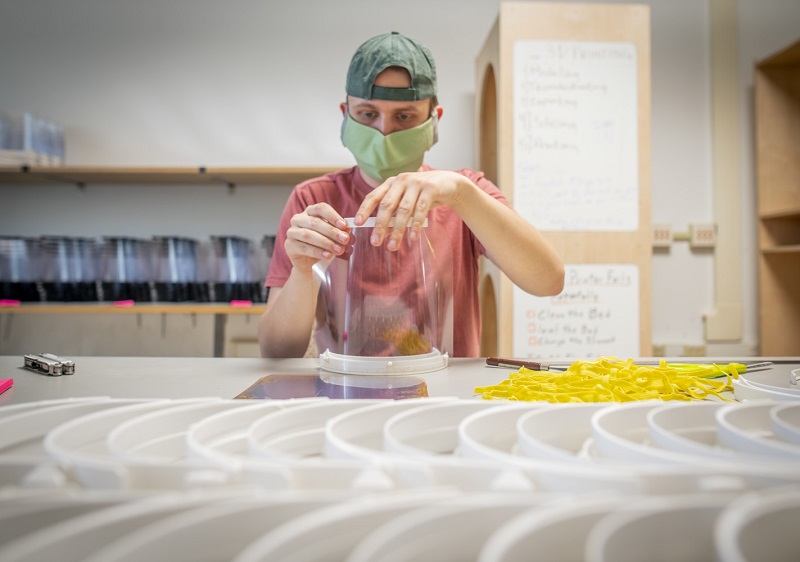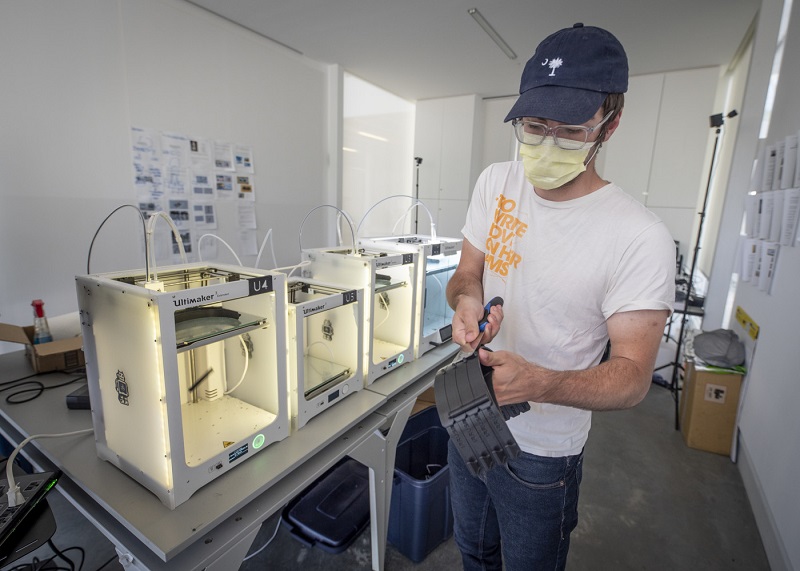
Clemson Architecture Students Repurpose 3D Printers to Create Face Shields for First Reponders
It’s a selfless sentiment seen time and again among the Clemson community since the COVID-19 crisis began. At the College of Architecture, Arts and Humanities (CAAH), a group of research professors, graduate students and 2020 graduates took 18 3D printers normally used to make scale models and repurposed them to make face shields.
Led by Winifred Newman, director of the Clemson University Institute for Intelligent Materials, Systems and Environments (CU-iMSE), and Shan Sutherland, lecturer and manager of the Digital Design Studio and Materials Lab, the group set up five workspaces scattered far apart in the 55,000-square-foot Lee Hall to ensure social distancing and safety.
The team produced 500 shields within a matter of weeks and plans to deliver 1,000 of the units to Clemson’s first responders. A separate group called Clemson University Makerspace – made of undergraduate students in marketing, graphic communication, architecture and mechanical engineering – is contributing another 1,000 from their workspace in the Watt Family Innovation Center.
The FDA approved their design, and each shield is sanitized after assembly and sits for at least two days before being delivered.
“We’re one of the bigger makerspaces on campus, so this is a great way to put the space to use during this time,” said Sutherland. “Phoenix Textiles of Landrum, which is owned by Clemson alumni, donated 5,000 feet of elastic to us to make shields, and our students jumped right in to put it to good use.”
Sutherland said the four students and recent graduates working on the face shields are great examples of the Clemson Family.
“Don’t forget that when all this started, these students were in the middle of taking finals. If I know them, they were also helping other students finish the semester. Add researching and producing these face shields and doing all this while trying to figure out how to finish your graduate studies strong while being kind of hamstrung – they are the best of the best,” Sutherland said.
Newman said the focus is to produce PPE safely, making sure to follow FDA guidelines and participate in a coordinated supply chain so the equipment goes where it is needed.
“As part of the land-grant mission to serve the larger state community we are only one small part of the system,” she said. “There are innumerable people at the University contributing their time and effort to supporting first responders and anyone else on the front lines of this pandemic.”
Back in Lee Hall, Arthur Southern and Mason Blackwell spend six hours a day in their workspaces making PPE parts for first responders, mere weeks after receiving their master’s degrees in architecture. Even though they are doing this instead of embarking on the first steps of their careers, both are grateful for the opportunity.
“I was not able to get a job elsewhere right now, so figured I might as well help out where I can,” said Southern. “Not everyone has this kind of ability or these machines, and there’s a shortage, so someone needs to help out. I don’t see this as stopping my life plan – it’s just a pause.”
Photo (Above): Kevin Crumley, a graduate student from Greenville, S.C. in Clemson University’s architecture program poses with rows of face shield head bands produced with 3D printers by a group of students and recent graduates. May 2020. (Photo by Ken Scar)


Read full article, “Preparing PPE for health providers and first responders; leveraging Clemson’s talent pool and resources,” on Clemson’s digital “NewsStand.”
Image Credits: Clemson University Relations. | Photographs and material from Clemson University Relations used by permission.






